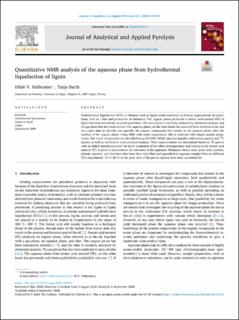Quantitative NMR analysis of the aqueous phase from hydrothermal liquefaction of lignin
Journal article, Peer reviewed
Published version

Åpne
Permanent lenke
https://hdl.handle.net/11250/2759803Utgivelsesdato
2020-08-06Metadata
Vis full innførselSamlinger
- Department of Chemistry [433]
- Registrations from Cristin [9766]
Originalversjon
Journal of Analytical and Applied Pyrolysis. 2020, 151, 104919 10.1016/j.jaap.2020.104919Sammendrag
Hydrothermal liquefaction (HTL) of biomass such as lignin could contribute to finding replacements for petroleum, both as a fuel and production of chemicals. The organic phase produced in formic acid assisted HTL of lignin has been extensively analyzed previously. The solid phase is routinely analyzed by elemental analysis, and the gas phase has also been studied. The aqueous phase, on the other hand, has received little attention so far and this paper aims to identify and quantify the organic compounds that remain in the aqueous phase after the workup of the organic phase. Using NMR with water suppression, this is achieved with simple sample preparation. The major components are identified using 2D NMR (HSQC spectra) together with proton spectra and 13C spectra as well as verification with standard samples. Their concentrations are determined based on 1H spectra with an added internal standard. An initial evaluation of the effect of temperature and catalyst in the formic acid assisted HTL is given to demonstrate the relevance of the approach. Methanol, formic acid, acetic acid, acetone, phenol, catechol, and dimethyl ether have been identified and quantified in aqueous samples from six different HTL-experiments. 76 %–86 % of the peak area of the proton spectra have been accounted for.
